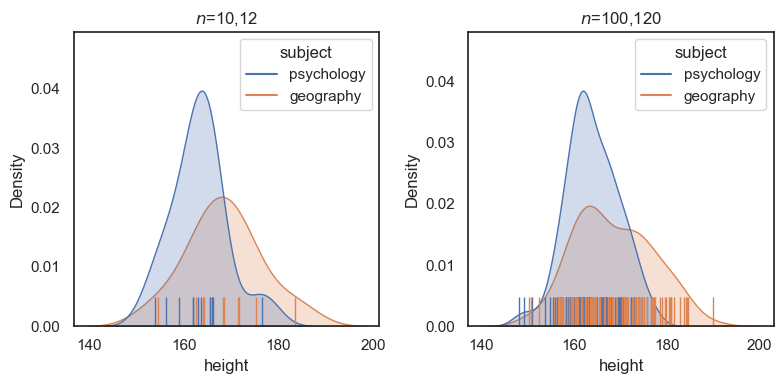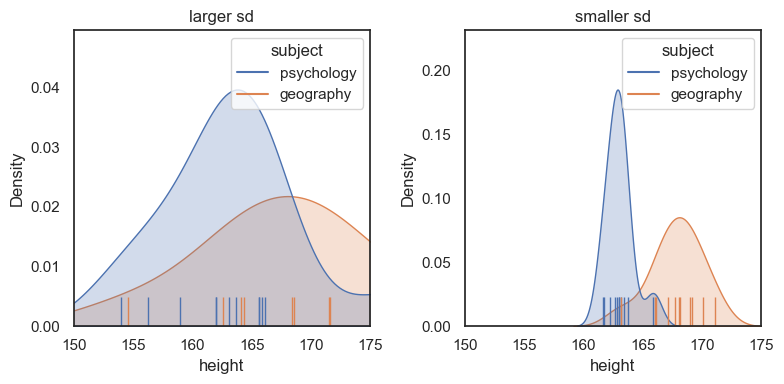4.4. Effect size (Cohen’s d)#
The first ingredient in a power analysis is effect size.
Power analysis determines the sample size needed to detect an effect of a certain size.
What is effect size? It is a measure of whether the effect (difference of means, correlation) of interest is big or small, relative to the random noise or variability in the data.
In this notebook we look at the effect size for the \(t\)-test and for Pearson’s correlation. We will see that:
The effect size for the \(t\)-test is Cohen’s \(d\), where
The effect size for Pearson’s correlation is simply the correlation coefficient, \(r\)
4.4.1. Video#
Here is a video explaining the idea of effect size for:
difference of means (Cohen’s \(d\))
correlation (Spearman’s \(r\))
%%HTML
<iframe width="560" height="315" src="https://www.youtube.com/embed/-KArntUcuys?si=cLeSnhcL7lycqtDj" title="YouTube video player" frameborder="0" allow="accelerometer; autoplay; clipboard-write; encrypted-media; gyroscope; picture-in-picture; web-share" referrerpolicy="strict-origin-when-cross-origin" allowfullscreen></iframe>
Set up Python libraries#
As usual, run the code cell below to import the relevant Python libraries
# Set-up Python libraries - you need to run this but you don't need to change it
import numpy as np
import matplotlib.pyplot as plt
import scipy.stats as stats
import pandas as pd
import seaborn as sns
sns.set_theme(style='white')
import statsmodels.api as sm
import statsmodels.formula.api as smf
4.4.2. Effect size for the \(t\)-test#
Example:
A researcher hypothesises that geography students are taller than psychology students.
\(\mathcal{H_o}:\) The mean heights of psychology (\(\mu_p\)) and geography (\(\mu_g\)) students are the same; \(\mu_p = \mu_g\)
\(\mathcal{H_a}:\) The mean heights of geography students is greater than the mean height of psychology students; \(\mu_g > \mu_p\)
He measures the heights of 12 geography students an 10 psychology students, which are given in the dataframe below:
heights=pd.read_csv('https://raw.githubusercontent.com/jillxoreilly/StatsCourseBook_2024/main/data/PsyGeogHeights.csv')
heights
| studentID | subject | height | |
|---|---|---|---|
| 0 | 186640 | psychology | 154.0 |
| 1 | 588140 | psychology | 156.3 |
| 2 | 977390 | psychology | 165.6 |
| 3 | 948470 | psychology | 162.0 |
| 4 | 564360 | psychology | 162.0 |
| 5 | 604180 | psychology | 159.0 |
| 6 | 770760 | psychology | 166.1 |
| 7 | 559170 | psychology | 165.9 |
| 8 | 213240 | psychology | 163.7 |
| 9 | 660220 | psychology | 165.6 |
| 10 | 311550 | psychology | 163.1 |
| 11 | 249170 | psychology | 176.6 |
| 12 | 139690 | geography | 171.6 |
| 13 | 636160 | geography | 171.5 |
| 14 | 649650 | geography | 154.6 |
| 15 | 595280 | geography | 162.6 |
| 16 | 772880 | geography | 164.4 |
| 17 | 174880 | geography | 168.6 |
| 18 | 767580 | geography | 175.3 |
| 19 | 688870 | geography | 168.4 |
| 20 | 723650 | geography | 183.5 |
| 21 | 445960 | geography | 164.1 |
Let’s calculate the sample mean for each subject group:
heights.groupby('subject').height.mean()
subject
geography 168.460
psychology 163.325
Name: height, dtype: float64
So the Geography students are about 5cm taller than the Psychology students.
Is this a large difference? Would it be obvious in a psychology-geography student party who is a psychology student and who is a geography student, just from their heights?
We can visualise how much the populations overlap by plotting them:
# plot KDEs
sns.kdeplot(data=heights, x='height', hue='subject', fill=True)
sns.rugplot(data=heights, x='height', hue='subject', height=0.1)
plt.show()
/opt/anaconda3/anaconda3/lib/python3.11/site-packages/seaborn/_oldcore.py:1119: FutureWarning: use_inf_as_na option is deprecated and will be removed in a future version. Convert inf values to NaN before operating instead.
with pd.option_context('mode.use_inf_as_na', True):
/opt/anaconda3/anaconda3/lib/python3.11/site-packages/seaborn/_oldcore.py:1119: FutureWarning: use_inf_as_na option is deprecated and will be removed in a future version. Convert inf values to NaN before operating instead.
with pd.option_context('mode.use_inf_as_na', True):

Hm, no, we probably could not tell who is a psychology student and who is a geography student, just from their heights, but it looks like there is a difference between the groups overall.
Effect size \(\neq\) statistical significance#
We could ask if there is a statistically signifiant difference between the groups by running a \(t\)-test:
stats.ttest_ind(heights.query('subject=="geography"').height,
heights.query('subject=="psychology"').height,
alternative='greater')
Ttest_indResult(statistic=1.7743564827449236, pvalue=0.04561467878556142)
The difference is just significant at \(\alpha\)=0.05 - our \(p\)-value is 0.0456
However, this doesn’t really tell us whether the effect is big (whether we could easily spot a tall geography student at a Psychosoc party), because the value of \(t\) also depends on the sample size, \(n\). To illustrate this, consider the following sample heights2, which is ten times larger (120 psychology students and 100 geography students), but with the same mean and sd in each group as the small (\(n\) = 12,10) sample:
heights2 = pd.read_csv('https://raw.githubusercontent.com/jillxoreilly/StatsCourseBook_2024/main/data/heightsLargerSample.csv')
plt.figure(figsize=(8,4))
plt.subplot(1,2,1)
plt.title('$n$=10,12')
sns.kdeplot(data=heights, x='height', hue='subject', fill=True)
sns.rugplot(data=heights, x='height', hue='subject', height=0.1)
plt.subplot(1,2,2)
plt.title('$n$=100,120')
sns.kdeplot(data=heights2, x='height', hue='subject', fill=True)
sns.rugplot(data=heights2, x='height', hue='subject', height=0.1)
plt.tight_layout()
plt.show()
/opt/anaconda3/anaconda3/lib/python3.11/site-packages/seaborn/_oldcore.py:1119: FutureWarning: use_inf_as_na option is deprecated and will be removed in a future version. Convert inf values to NaN before operating instead.
with pd.option_context('mode.use_inf_as_na', True):
/opt/anaconda3/anaconda3/lib/python3.11/site-packages/seaborn/_oldcore.py:1119: FutureWarning: use_inf_as_na option is deprecated and will be removed in a future version. Convert inf values to NaN before operating instead.
with pd.option_context('mode.use_inf_as_na', True):
/opt/anaconda3/anaconda3/lib/python3.11/site-packages/seaborn/_oldcore.py:1119: FutureWarning: use_inf_as_na option is deprecated and will be removed in a future version. Convert inf values to NaN before operating instead.
with pd.option_context('mode.use_inf_as_na', True):
/opt/anaconda3/anaconda3/lib/python3.11/site-packages/seaborn/_oldcore.py:1119: FutureWarning: use_inf_as_na option is deprecated and will be removed in a future version. Convert inf values to NaN before operating instead.
with pd.option_context('mode.use_inf_as_na', True):

Although the mean and sd for each group are about the same, if we conduct a \(t\)-test on the larger dataset, we find the difference is much more significant
# small sample size
stats.ttest_ind(heights.query('subject=="geography"').height,
heights.query('subject=="psychology"').height,
alternative='greater')
Ttest_indResult(statistic=1.7743564827449236, pvalue=0.04561467878556142)
# large sample size
stats.ttest_ind(heights2.query('subject=="geography"').height,
heights2.query('subject=="psychology"').height,
alternative='greater')
Ttest_indResult(statistic=4.770032273659233, pvalue=1.6851503676180662e-06)
Conclusion the \(t\)-test cannot tell us whether the effect of subject studied on height is large or small - for this we need a ‘pure’ measure of the size of the difference relative to variability, regardless of \(n\)
4.4.3. Variance matters for effect size#
Is a 5cm difference in height between psychology and geography students a big effect? How easily could we spot a tall geographer gatecrashing the Psychosoc party?
This will depend on both the difference in mean heights, and the standard deviation (variablity) within each group.
Consider the following dataset which has the same difference in means, but now much less variability within each group:
heights3 = pd.read_csv('https://raw.githubusercontent.com/jillxoreilly/StatsCourseBook_2024/main/data/heightsSmallerSD.csv')
plt.figure(figsize=(8,4))
# plot KDEs
plt.subplot(1,2,1)
plt.title('larger sd')
sns.kdeplot(data=heights, x='height', hue='subject', fill=True)
sns.rugplot(data=heights, x='height', hue='subject', height=0.1)
plt.xlim([150,175])
plt.subplot(1,2,2)
plt.title('smaller sd')
sns.kdeplot(data=heights3, x='height', hue='subject', fill=True)
sns.rugplot(data=heights3, x='height', hue='subject', height=0.1)
plt.xlim([150,175])
plt.tight_layout()
plt.show()
/opt/anaconda3/anaconda3/lib/python3.11/site-packages/seaborn/_oldcore.py:1119: FutureWarning: use_inf_as_na option is deprecated and will be removed in a future version. Convert inf values to NaN before operating instead.
with pd.option_context('mode.use_inf_as_na', True):
/opt/anaconda3/anaconda3/lib/python3.11/site-packages/seaborn/_oldcore.py:1119: FutureWarning: use_inf_as_na option is deprecated and will be removed in a future version. Convert inf values to NaN before operating instead.
with pd.option_context('mode.use_inf_as_na', True):
/opt/anaconda3/anaconda3/lib/python3.11/site-packages/seaborn/_oldcore.py:1119: FutureWarning: use_inf_as_na option is deprecated and will be removed in a future version. Convert inf values to NaN before operating instead.
with pd.option_context('mode.use_inf_as_na', True):
/opt/anaconda3/anaconda3/lib/python3.11/site-packages/seaborn/_oldcore.py:1119: FutureWarning: use_inf_as_na option is deprecated and will be removed in a future version. Convert inf values to NaN before operating instead.
with pd.option_context('mode.use_inf_as_na', True):

For the dataset on the right (lower sd within each group) we can see a much clearer separation between the psychology and geography students - in practical terms, it would be easier to guess a person’s subject based on their height.
The plot on the right has a larger effect size, as we shall see in the next section
4.4.4. Cohen’s \(d\)#
We quantify the effect size for the difference of means as Cohen’s \(d\):
where:
\(\bar{x_g}\) is the mean height of our sample of geography students
\(\bar{x_p}\) is the mean height of our sample of psychology students
\(s\) is the shared standard deviation estimate basaed on the standard deviations of the samples, \(s_p\) and \(s_g\):
oof! The shared variance (or sd) estimate, \(s\), is just a way of getting a single ‘average’ standard deviation measure when we have two sample standard deviations for our two groups, and is actually part of the equation from the independent samples \(t\)-test.
Let’s implement that:
# calculate shared standard deviation s
xP = heights.query('subject=="psychology"').height.mean()
xG = heights.query('subject=="geography"').height.mean()
sP = heights.query('subject=="psychology"').height.std()
sG = heights.query('subject=="geography"').height.std()
nP = heights.query('subject=="psychology"').height.count()
nG = heights.query('subject=="geography"').height.count()
s=(((nP-1)*(sP**2) + (nG-1)*(sG**2))/(nP+nG-2))**0.5 # **0.5 means 'to the power of a half' ie square root
s
6.758944074335872
\(s\) is an estimate of the standard deviation of heights, based on both groups, so it should be similar to the standard deviation of each of the individual groups.
Now we can calculate our effect size:
# Cohen's d
d=(xG-xP)/s
d
0.759734056610692
So \(d=0.76\), ie the difference in mean heights between psychology and geography students is 0.76 standard deviations.
Effect size is a standardized measure#
Note that in dividing the difference by the standard deviations, we are quantifying the overlap between the two distributions independent of the data values themselves.
Therefore it is possible to have quite different datasets with the same effect size - for example if the difference of means and the standard deviations both increase, effect size may stay the same.
For example, here I have created another dataset with the same effect size \(d=0.760\), comparing the weights of (fictional) black and grey sheep:
sheep=pd.read_csv('https://raw.githubusercontent.com/jillxoreilly/StatsCourseBook_2024/main/data/SheepWeights.csv')
# plot KDEs for psy/geog heights
plt.subplot(2,1,1)
sns.kdeplot(data=heights, x='height', hue='subject', fill=True)
plt.xlabel('student height (cm)')
plt.xlim([50,300])
plt.ylim([0,0.04])
# plot KDEs for black/grey sheep weights
plt.subplot(2,1,2)
sns.kdeplot(data=sheep, x='weight', hue='woolColor', fill=True)
plt.xlabel('sheep weight (lb)')
plt.xlim([50,300])
plt.ylim([0,0.04])
plt.tight_layout()
plt.show()
/opt/anaconda3/anaconda3/lib/python3.11/site-packages/seaborn/_oldcore.py:1119: FutureWarning: use_inf_as_na option is deprecated and will be removed in a future version. Convert inf values to NaN before operating instead.
with pd.option_context('mode.use_inf_as_na', True):
/opt/anaconda3/anaconda3/lib/python3.11/site-packages/seaborn/_oldcore.py:1119: FutureWarning: use_inf_as_na option is deprecated and will be removed in a future version. Convert inf values to NaN before operating instead.
with pd.option_context('mode.use_inf_as_na', True):

Although the ‘sheep’ data are much more spread out, the difference of means between groups is also larger.
These two different datasets therefore have the same effect size, which quantifies the overlap between groups (psychology and geography students, or black and grey sheep)
Small, medium and large effects#
Cohen himself defined small medium and large effects as follows:
\(d=0.2\): small effect
\(d=0.5\): medium effect
\(d=0.8\): large effect
stating that “a medium effect of 0.5 is visible to the naked eye of a careful observer”
This is what the effect sizes look like for normally distributed data:
Of course, even tiny differences are “visible to the naked eye” for these smooth curves; in contrast, for real data, there will be uncertainty about how well some fitted curve (KDE plot) really represents the underlying population - hence to ascertain our confidence in the difference (statistical significance), we must consider the sample size \(n\) as well as effect size.
4.4.5. Recovering \(d\) from \(t\)#
Most published papers do not report effect sizes or Cohen’s \(d\) for \(t\)-tests
However, they do report \(t\) values and sample sizes.
\(d\) can be recovered relatively simply from \(t\) and \(n\) - the formulae for this (for the paired and unpaired t-test) are given in the page Determining effect size
This is important as we often need to use the effect size from a published study to estimate the effect size in a study we are planning, and thus select the correct sample size via power analysis. This process will be explored later in this chapter.


